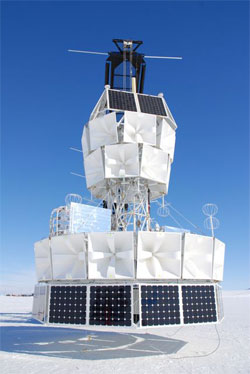Nuclei Cooperate to Produce Single Particle
When an energetic photon smashes into matter, it can create a massive particle, the rho meson, when it strikes an atomic nucleus. A report in the 7 August Physical Review Letters shows that such a photon can also produce the particle in an interaction that involves many nuclei simultaneously. This so-called coherent production grows in importance as the photon energy increases and must be accounted for in analyses of data from the highest energy particles from space, including cosmic rays and neutrinos.
To learn about the highest energy cosmic rays and neutrinos–some with energies of electron-volts (eV) or more–astrophysicists want to understand the ultrahigh energy photons and other particles created when the cosmic particles hit our atmosphere or Antarctic ice. A high energy photon is accompanied by a cloud of virtual quark-antiquark pairs, which constantly flicker into and out of existence. One of these pairs, bouncing off a nucleus, can transform into a neutral rho meson, which goes on to make more mesons, either by decaying or by smashing into other nuclei. The result is a shower of quark-containing, or “hadronic,” particles, rather than the electrons, positrons, and photons produced in more common, so-called electromagnetic showers.
Conventional wisdom has long been that photons produce hadronic showers much more rarely than electromagnetic showers. But in 2002 John Ralston of the University of Kansas in Lawrence and his colleagues posted a paper on the Arxiv preprint server arguing that for ultrahigh photon energies, hadronic showers cannot be ignored [1].
Now Elsa Couderc of Lawrence Berkeley National Laboratory (LBNL) in California and the École Normale Supérieure in Paris and Spencer Klein of LBNL and the University of California, Berkeley, have firmly established the significance of the hadronic shower and discovered a new contribution to it. They estimate the likelihood of rho production for a photon crashing into various forms of matter: water, rock, and lead. Many uncertainties feed into the calculations, but the answers are roughly the same in all three cases. Photons with energies greater than about eV, they find, lose more energy through rho production leading to hadronic showers than through electromagnetic showers.
They also describe a previously unnoticed phenomenon that gives an additional boost to rho meson production. For a photon with energy well above the rho’s mass of 780 million electron-volts (MeV), the rho will have so much energy that its mass is negligible. With insignificant mass compared with its energy, the rho is a bit like a massless photon, and the momentum difference between the initial photon and the rho it produces is very small. The uncertainty principle tells us that a small change in momentum can only occur in a large volume of space.
For a photon energy of about eV, the so-called coherence length of the particle reaction is 0.2 nanometers, the typical spacing between nuclei in solids or liquids. In other words, a photon with energy this large can produce a rho meson in an interaction that involves several nuclei simultaneously. The large coherence length reactions required special attention in Couderc and Klein’s calculations, and they turned out to contribute significantly at the highest energies.
It’s not until the photon energy reaches eV, however, that rho production through this coherent mechanism exceeds rho production by interaction with individual nuclei. At such energies, the coherence length is measured in meters, meaning that a photon creates a rho in an interaction occurring through the entirety of a large slab of matter. Some cosmic neutrinos, astrophysicists argue, may have enough energy to produce such photons.
Couderc and Klein’s work makes it possible to reliably estimate effects that were previously neglected in models of photon shower development, says Ralston, and that’s important in studies of ultrahigh energy cosmic rays. “When photons misbehave, we need to know about it,” he says.
–David Lindley
David Lindley is a freelance science writer in Alexandria, Virginia.
References
- John P. Ralston, Soebur Razzaque, and Pankaj Jain, “Ultra-high Energy Quenching of the LPM Effect: Implications for GZK-Violating Events,” arXiv:astro-ph/0209455
More Information
ANITA results (limits on neutrino flux) from 2006 flight: P. W. Gorham et al., “New Limits on the Ultrahigh Energy Cosmic Neutrino Flux from the ANITA Experiment,” Phys. Rev. Lett. 103, 051103 (2009)





